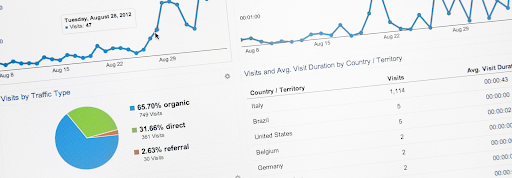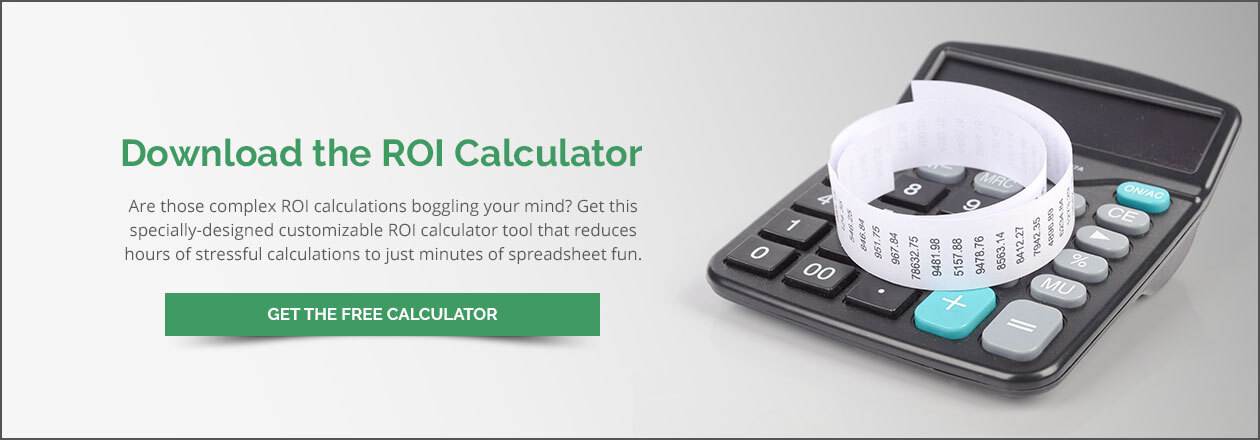Navigating the relationship between digital marketing and analytics
You can't separate digital marketing and analytics today. Data-backed decisions drive more success with your digital marketing strategy, which means collecting and crunching numbers is a critical component of running a successful agency.
Are those complex ROI calculations causing mind-boggling confusion? DOWNLOAD your free ROI calculator today.
The good news is that you don't have to be a math or statistics whiz to understand and use digital marketing analytics. After learning about marketing metrics and what they mean for your campaigns, you can leverage technology tools to handle the calculations for you—and even present actionable findings in easy-to-understand visual formats. Get started by learning more about digital marketing analytics in the guide below.
What are analytics used for in digital marketing?
Analytics for digital marketing are important enough to garner a specific budget line item. On average, chief marketing officers say they allocate around 6.5 percent of their overall budget to data analytics (WebFX). But what does a digital agency get for this marketing spend?
Some use cases for analytics include:
- Measuring campaign performance. Data analytics help you understand whether your lead generation strategies are working or not. That way, you’re not wasting money and marketing effort on campaigns that underperform, and you can invest in strategies that lead to higher conversion rates.
- Understanding customer behavior. Analytics help you understand the market and consumer so you’re better positioned to launch winning campaigns out of the gate.
- Optimizing marketing strategies. A/B testing and other analytic methods help you tweak campaigns and strategies for optimal performance. This can lead to continuous improvement in your client offerings over time.
- Tracking key metrics. Understanding and monitoring key performance metrics is a must-have agency skill. Key metrics help you report your efforts to clients and demonstrate the value of your services.
- Identifying trends. Keeping up with trends is critical to success in digital marketing, where a change in search algorithms or consumer behavior can derail performance or require you to evolve campaigns quickly.
- Making data-driven decisions. While experts may be tempted to go with their gut, it’s important to make data-driven decisions in digital marketing. You can’t do that without good analytics.
Why analytics for digital marketing is important
Whether you’re launching a digital agency startup or growing an established agency, analytics remain critical to success. Digital marketing analysis is a significant component of establishing and maximizing return on investment (ROI), identifying agency and campaign strength and weaknesses, targeting the right audience, and enhancing customer experience.
Consider some real-world examples to understand the importance of analytics:
- A clothing boutique offers a line of products for children. Digital analytics identifies all the target audiences for potential campaigns. It’s not enough to simply target parents. Dynamic marketing efforts that take into account sector demographics such as income and interests—and help build opportunities for connecting with secondary audiences such as grandparents—enhance overall sales success.
- An agency has a new client and needs to show ROI. Without analytics demonstrating performance with the right metrics, you can’t wow your new client and demonstrate the value of your services. Clients want to see evidence of improvement, and you can do that with visual depictions of metric analysis.
- Your ecommerce client wants a website that enhances customer satisfaction. Aside from specific customer feedback about the site, user behavioral metrics are a great way to demonstrate that you moved the needle on customer satisfaction. If people are staying on page longer, engaging more with page elements, and converting as the client desires, these metrics indicate that the site works better to serve customers.
Where does data for digital marketing and analytics come from?
Agency owners and marketing teams must be aware of where marketing data comes from. Common sources include:
- Website analytics tools. Whether you use website builder tools or code sites from scratch, the importance of web analytics in digital marketing doesn’t change. Ensure you have access to dashboards that help you understand how websites are functioning and whether users who visit the site are converting.
- Social media platforms. Social media platforms provide many metrics, including information about post engagement such as likes, shares, and comments. Consider how you can pull data from those platforms into a single source of truth so you can review all marketing metrics at once.
- Email marketing tools. Email marketing platforms also provide metrics, including delivery, open, and click-through rates. Again, you might want to consider how to import these metrics into a single system for easy management.
- Customer relationship management (CRM) systems. Client CRM systems contain a lot of data about existing customers you can use to inform targeted marketing campaigns.
What you need to conduct analytics for digital marketing
To conduct appropriate analytics and support your digital marketing efforts, you need technology tools. Old-school analytics involved importing data into Excel and manually massaging it to draw conclusions. The sheer amount of data available to you today makes manual efforts difficult or even impossible, but you can leverage AI and automated tools to help. At the same time, you still need skilled analysts to draw appropriate conclusions.
Some technology you might want to invest in includes:
- Web analytics tools for digital marketing, which gather data about website and search engine optimization (SEO) performance
- Data visualization tools that help you present data in easy-to-understand charts and graphs
- Customer segmentation software that uses analytics to segment your audience for more targeted marketing
- White label reporting, which helps you scale your marketing and analytics services without additional hiring in-house staff
How to collect data for digital marketing and analytics
You can collect digital marketing data with:
- Website tracking tools. Integrated website tools capture information such as page traffic, traffic sources, bounce rate, time on page, and click-through rate. You can also use tools like heat maps to understand exactly how users engage with each page.
- Social media and third-party data monitoring. Third-party listening and data monitoring tools help you understand what your audience does off of your website. This includes engagement with social media and email campaigns as well as general online behavior, such as what keywords people are interested in.
- Surveys and customer feedback tools. Sometimes, you need to go directly to the customer for marketing data. Surveys, polls, and interview tools help you get feedback about marketing campaigns and products that can inform future efforts.
How to build a strategy using analytics for digital marketing
Following the steps below helps you use data analytics in digital marketing to support your strategies.
Set clear objectives
Whether you want to engage in local SEO reporting or use data to enhance email marketing efforts, ensure your goals are clear. Use SMART goal setting to create objectives that are specific, measurable, achievable, relevant, and time-bound.
Define key performance indicators (KPIs)
Once you have a clear goal, define which analytics for digital marketing are most relevant. For example, cost per acquisition (CPA) is relevant for goals related to marketing budgets and conversions. However, you might need to consider engagement metrics if your goals are related to building brand awareness on social media.
Analyze data to gain insights
Use the appropriate calculations and analytics tools to draw insights from the data you collect. For example, an ROAS calculation can help you demonstrate to clients that your ad campaigns are driving strong value. The takeaway in this case would be that the client may want to keep investing in—or even invest more in—these campaigns.

Make improvements and repeat the process
Tweak marketing strategies and campaigns to improve processes based on the findings from your data analytics efforts. Consider some of the examples below to understand how analytics can inform marketing activity.
- Delivery rates are low for an email campaign. This indicates potential problems with the subscriber list. You may need to clean the list to remove bad emails or check your email campaigns to ensure there isn’t a technical glitch.
- Click-through on ad campaigns is low. This could indicate that the ads are not being served to the right audience or that there are problems with the design and text of the ads. A/B testing can help you determine where the flaw is so you can correct it.
- Page traffic is high but conversion and click-through rates are low. In this case, you may be attracting the wrong traffic to the page or your landing pages may not perform well. Again, you can use A/B testing and other tools to try various fixes to find what works.
Embrace analytics and data in marketing
The role of data in marketing grows every day—as does the amount of data available to marketing agencies and teams. By investing in digital marketing and analytics today, you create a strong foundation that helps your business succeed in the future.
Consider where your agency is blind when it comes to marketing data now and how you can leverage technology tools to gain insight into those areas. By making informed marketing decisions for yourself and your clients, you position your agency for continued growth.




